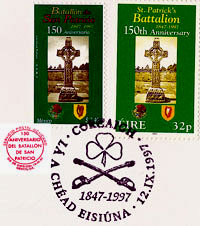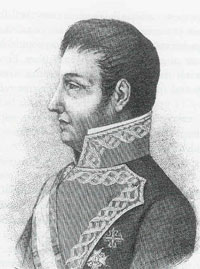|

Joint issuance of stamps by
Correos de México and An Post
(12 September 1997) |
Another
well-known member of the O'Reilly clan in Mexico was the
intrepid leader of the San Patricio Companies who fought
against the North American invading forces during the
so-called Mexican War (1846-1848). He is known to US
historians as John Riley, an Irish-born deserter from the US
Army; but in Mexico he is remembered as El Capitán Juan
O'Reilly of the San Patricios, who distinguished himself
for his skill and bravery as an artillerist in many bloody
encounters with the US invaders. His military exploits have
become well known in recent years due to various books and
documentaries, as well as the
Hollywood movie One Man's Hero, which provoked much controversy on both
sides of the US-Mexican border.
Missionaries, Soldiers and Artists
Eugene
MacNamara is referred to by historians as an 'Apostolic
Missionary' in Mexico who conceived a grandiose plan to settle
ten thousand Irish immigrants in northern California in the
early 1840s, when that region was still under Mexican
jurisdiction. Apparently, he had travelled extensively
throughout northern Mexico and the Mexican government was
supportive of his colonisation project in the hope that an
Irish Catholic settlement would serve as a defence against the
encroaching North Americans who were casting covetous eyes on
the rich gold deposits in that area. The project had to be put
on hold due to the outbreak of hostilities between the US and
Mexico in 1846, and came to an abrupt end when all of Mexico's
northern territories were ceded to the United States under the
terms of the Treaty of Hidalgo in 1848.
MacNamara was
mentioned in US Army records as an Irish Catholic priest who
was responsible for the desertion of Irish soldiers who joined
the San Patricio Companies to fight against the invading US
forces. Some US officers called for his arrest and execution,
but he managed to evade his would-be captors and apparently
lived to pursue his apostolic activities in a more favourable
environment.
|
The
Ancient Order of Hibernians at Jalisco, Mexico
'I believe I occupy a
unique position, representing a state where every
Irishman in the state is a Hibernian. We have but 18
Irish Catholics in the state of Jalisco. Each one is a
member of Division No.1, of which I am president. I have
learned through that organization the secret of how to
keep members in good standing in the organization. When
his dues are due I pay the dues. When he dies I pay his
funeral expenses (laughter and applause). Although we
have but very few members-but 18 here, they are loyal,
genuine Irish boys, every one of them, who are glad to
meet their Irish brothers from the States when they
visit us, and will be glad to meet them at the next
convention, and I hope Mexico will send 10
representatives instead of one.' This was communicated
by Edward Blewitt at the 1902 national convention. See
John T. Ridge, Erin’s Sons in America - The Ancient
Order of Hibernians (Brooklyn, NY: AOH Publications,
1986), p. 137. |
Another
controversial cleric of that same period was Miguel Muldoon,
who came to Mexico from Spain in the company of the Spanish
Viceroy General Juan O'Donojú in 1821, and volunteered to work
as a missionary in the region that was soon destined to become
the US state of Texas. He earned a reputation as a friend and
collaborator of the Anglo-Protestant immigrants to Texas, who
were not eligible for land grants under Mexican law. Muldoon,
it seems, supplied them with Catholic baptismal and marriage
certificates, and apparently his 'converts' made some kind of
profession of faith in the Catholic church and thereby became
eligible to receive Mexican land grants. This unusual
ecclesiastical procedure gave rise to the cynical expression
'Muldoon Catholics' in the Lone Star state. Apparently,
Muldoon was born in Ireland and emigrated to Spain where he
was ordained a priest at the Irish Seminary in
Seville.
He received a land grant from the Mexican government near
Saltillo
in 1831, which he later disposed of, but his name survives in
the small rural district of Muldoon, Texas to the present day.
Some historians claim that he was expelled from Mexico as a
persona non grata due to his collaboration with the
leaders of the Texan rebellion against the Mexican government
in 1836. An historical monument in Texas hails him as 'the
Forgotten Man of Texas Independence'.
General Juan
O'Donojú (O'Donohue) was one of the most outstanding
soldiers in the Spanish Army, and had served as aide-de-camp
to the Spanish king. He was appointed Viceroy to New Spain
(Mexico) in 1821, and was given the task of putting an end to
the War of Independence which had commenced in 1810. However,
when O'Donojú arrived in Mexico he realised that he had been
given an impossible task, and decided that Spain should reach
a negotiated settlement with the Mexican rebels and allow New
Spain to become the independent United States of Mexico. He
signed the Córdoba Treaty with the Mexican General Agustín
Iturbide in 1821, and thereby brought to an end Mexico's
eleven-year struggle for national independence.
|

Juan O'Donojú (1762-1821)
(J.V. Thomas) |
O'Donojú died
in
Mexico
that same year and was buried with great pomp and ceremony in
the Metropolitan Cathedral in Mexico City. Juan O'Donojú
Street in Mexico City perpetuates his memory as a friend and
collaborator of Mexican independence. At the entrance to the
Independence Monument in Mexico City is the statue of another
Irishman who is regarded as the precursor of Mexican
independence and known to history as Guillén Lombardo (William
Lamport) from
County Wexford. He was
condemned by the Holy Inquisition to be burned at the stake
for his heretical ideologies in 1659 (Irish Roots 54:
'Zorro').
The Irish
have also left their mark on the visual arts in modern Mexico,
where Juan O'Gorman (1905-1982) and Pablo O'Higgins
(1904-1983) have earned reputations as renaissance muralists
in the distinguished company of Diego Rivera and Clemente
Orozco. Edmundo O'Gorman (1906-1995) was one of Mexico's most
outstanding historians and literary personalities of the last
century.
Don Rómulo
O'Farrill, Jr. is one of Mexico's prominent entrepreneurs and
diplomats, and served as Ireland's Honorary Consul in Mexico
for over three decades, until the appointment of a resident
Irish Ambassador in 1999. The O'Farrills trace their Irish
roots back to
County
Longford by way of Spain, and the surname is associated with
publishing and other commercial enterprises throughout Mexico.
The Irish
Society of Mexico was organised in 1978, and has served as a
link between Mexicans of Irish lineage and their ancestral
homeland. This humble scribe was elected its first president,
and the organising committee included Irish expatriates Terry
Burgess, Liam McAlister, Stephanie Counihan, Deirdre O'Neill,
Catherine Corry, Matt McMahon, Allison O'Doherty and Séamus Ó
Fógartaigh.
The special
affinity between the Irish and Mexican cultures may be
traceable to St. Brendan and his disciples who may have left
an indelible Celtic imprint on Mexican culture and
spirituality some 1500 years ago.
Séamus
Ó
Fógartaigh
This article
is a revised version of 'Hiberno-Mexican Historical Links' in
Irish Roots Magazine, N° 58 (2006 Second Quarter).
References
-
Hogan, Michael, The Irish Soldiers of
Mexico
(Mexico: Fondo Editorial Universitario, 1997).
-
Ó
Fógartaigh, Séamus. 'The Man Behind the Mask of Zorro' in
Irish Roots N° 54 (Second Quarter 2005). |


